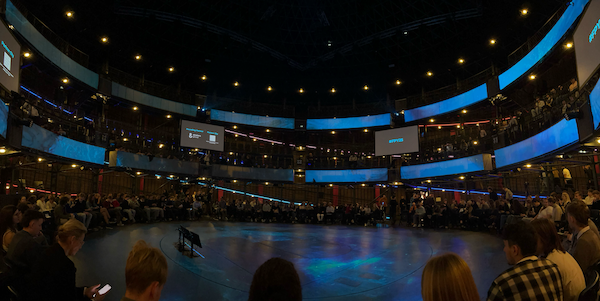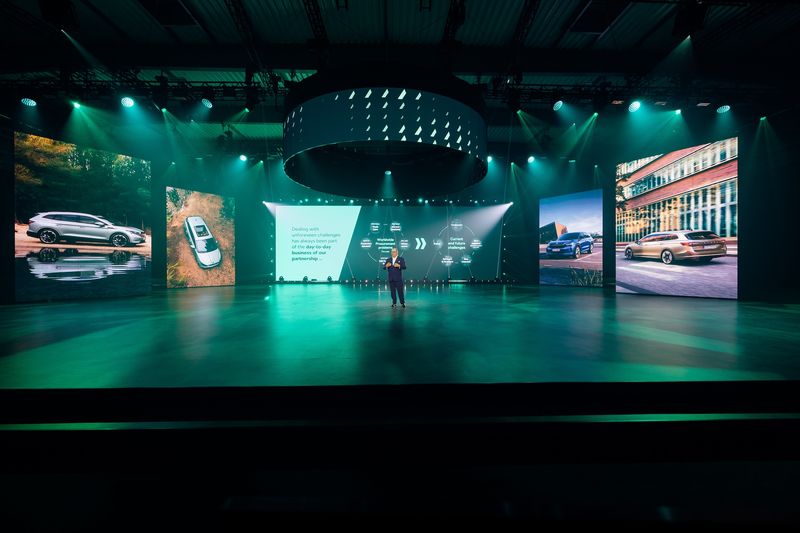Google Cloud Summit Prague 2025
At Google Cloud Summit Prague 2025, our Green:Code team showed up in full force at the Prague Congress Centre. Together with our colleagues from AppSatori, we showcased our brands at a joint booth and immersed ourselves in the latest trends and technologies from the world of Google Cloud AI. We came back with a solid dose of inspiration!

Expectations vs. Reality: When Theory Meets Practice
We came to the event expecting lots of theoretical talks about how AI is going to change the world. The reality, however, was much more engaging – instead of abstract visions, we got concrete use cases, live demos, and, most importantly, practical insights on how to actually implement AI into real-world projects.
What struck us most was how quickly the approach to AI application development is evolving. Instead of complex integrations, we saw tools that make AI truly accessible to everyday developers. As a company building software for Škoda Auto, we see huge potential in how these technologies can elevate user experience to an entirely new level.
NotebookLM: When AI Talks to Itself
One of the biggest wow moments came from a demo of NotebookLM in the Google Digital Garage. Three certified trainers showed us how to upload project documentation and generate an audio summary in the form of a dialogue between a man and a woman. The idea of two voices discussing your code and explaining its architecture is seriously cool.
Another highlight was the practical demo combining Gemini with Google Workspace, which illustrated how to safely use LLMs in enterprise environments — a key topic for us at Green:Code. Ensuring client data security when working with AI is one of the core pillars of our internal AI strategy.
Automation That Doesn’t Replace People — It Moves Business Forward
A real masterclass came from Dalibor Cicman of GymBeam, who demonstrated how automation powered by Google Cloud enables the company to grow by 30% annually without increasing headcount. It’s not about layoffs — it’s about empowering people to do more meaningful work.
Two examples really stood out:
- AI influencers promoting products (where customers often don’t even realize the person isn’t real).
- Automatically generated marketing campaigns built directly from technical documentation — upload your product drawings and get a full packaging proposal, complete with localized content.
Multi-Agent Systems: The Future That’s Already Here
A technical session on multi-agent systems in Vertex AI revealed fascinating ways to coordinate multiple specialized AI agents within one complex solution. Instead of relying on one “super-AI,” you can build an ecosystem of specialized agents that pass tasks between each other according to their expertise.
Experts from Deloitte also presented a real-world example: automating an entire insurance claim process, from report to payout. A router agent determines which specialized agent handles each step. The key takeaway? Focus on the main process — not every possible exception.
Google Sheets with AI: =AI(instruction; range)
Another neat update: Google Sheets can now process up to 200 cells at once using an AI function. That means QA teams can automatically generate test scenarios and analyze results directly in spreadsheets. Simple, but brilliant.
Vertex AI Model Garden: More Than Just Gemini
What surprised us most was how many different models are now available under one API. In addition to Gemini, you can leverage other specialized models for various tasks — all within the same security standards and unified interface. This makes integrating and testing multiple AI solutions far simpler.
Agentspace in Action: A Documentation Search Revolution
Another game-changer for project documentation management is Agentspace with its Deep Search and Quality Search features, combining several search technologies (Gemini, Web, Files, SharePoint) into a single interface.
Google Agentspace connectors also support systems outside the Google ecosystem — including Microsoft SharePoint, Confluence, and Jira, which makes this highly relevant for us at Green:Code.
Agentspace automation can even find supplier contact details directly on the web and automatically save them into a spreadsheet — a real time-saver during the research phase of projects.
Practical Takeaways
Thinking about how to best integrate AI into your projects? Thanks to the Google Cloud Summit, we’ve got plenty of ideas — and a few key recommendations:
🔹 Start small with a clear use case. Don’t try to automate an entire complex process right away. Pick one specific task where AI can bring tangible value and start there.
🔹 Security first. Always choose enterprise-grade solutions with strong data protection. When working with sensitive client information, there’s no room for compromise.
🔹 Test not only if it works — but if it works well. An AI system can be technically flawless yet still produce useless results. Output quality is just as critical as functionality. This is exactly where a new discipline emerges — AI Quality Assurance, an area we’ve been actively exploring at Green:Code.
🔹 Don’t rely on a one-size-fits-all solution. Combining multiple specialized tools is often more effective than one universal system. Each task may require a different approach.

Final Thoughts
The entire event made one thing clear: AI is no longer the future — it’s the present. The real challenge now is how to implement it effectively. Those who keep an open mind and aren’t afraid to experiment with new technologies will lead the way forward.
Just like we do at Green:Code.


.jpg)

.jpg)








